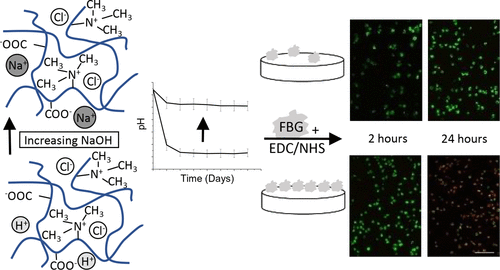Our official English website, www.x-mol.net, welcomes your feedback! (Note: you will need to create a separate account there.)
Enhanced Biocompatibility of Polyampholyte Hydrogels.
Langmuir ( IF 3.9 ) Pub Date : 2020-03-25 , DOI: 10.1021/acs.langmuir.0c00114 Stephanie L Haag 1 , Matthew T Bernards 1
Langmuir ( IF 3.9 ) Pub Date : 2020-03-25 , DOI: 10.1021/acs.langmuir.0c00114 Stephanie L Haag 1 , Matthew T Bernards 1
Affiliation

|
Tissue-engineered scaffolds encounter many challenges including poor integration with native tissue. Nonspecific protein adsorption can trigger the foreign body response leading to encapsulation and isolation from the native injured tissue. This concern is mitigated with nonfouling polymer scaffolds. This study investigates the long-term biocompatibility of a nonfouling polyampholyte system composed of positively charged [2-(acryloyloxy)ethyl]trimethylammonium chloride monomers and negatively charged 2-carboxyethyl acrylate monomers, cross-linked with triethylene glycol dimethacrylate. This system has previously shown resistance to nonspecific protein adsorption and short-term cell attachment via conjugated proteins. However, longer-term cell survival has not been evaluated with this system. First, the environmental pH was monitored with varying amounts of counter ions present in the hydrogel synthesis buffer. The lowest level (3 M NaOH) and the level that resulted in pH values closest to physiological conditions (6.7 M NaOH) were chosen for further investigation. These two formulations were then compared in terms of their contact angle, qualitative protein adsorption and conjugation capacity, and quantitative cell adhesion, proliferation, and viability. The 3 M NaOH formulation showed higher initial protein conjugation and cell adhesion compared to the 6.7 M NaOH formulation. However, the 3 M NaOH hydrogels had low cell viability after 24 h due to the acidic component release into the culture environment. The 6.7 M NaOH formulation showed a lower initial conjugation and cell adhesion but overcame this limitation by providing a stable environment that maintained cell viability for over 5 days. The 6.7 M NaOH polyampholyte hydrogel formulation shows increased biocompatibility, while maintaining resistance to nonspecific protein adsorption, as demonstrated by the targeted cell adhesion and proliferation. Therefore, this polyampholyte formulation demonstrates strong potential as a tissue-engineered scaffold.
中文翻译:

增强的两性电解质水凝胶的生物相容性。
组织工程化的支架面临许多挑战,包括与天然组织整合不良。非特异性蛋白质吸附会触发异物反应,从而导致被包裹和与天然受损组织隔离。使用防污聚合物支架可以减轻这种担忧。这项研究调查不结垢的两性体系的长期生物相容性,该体系由带正电的[2-(丙烯酰氧基)乙基]三甲基氯化铵单体和带负电的丙烯酸2-羧乙基酯单体组成,并与三乙二醇二甲基丙烯酸酯交联。该系统先前已显示出对非特异性蛋白吸附和通过结合蛋白的短期细胞附着的抵抗力。但是,该系统尚未评估长期细胞存活率。第一,用水凝胶合成缓冲液中存在的不同数量的抗衡离子监测环境pH。选择最低水平(3 M NaOH)和导致pH值最接近生理条件的水平(6.7 M NaOH)进行进一步研究。然后根据接触角,定性蛋白质吸附和结合能力以及定量的细胞粘附,增殖和生存力对这两种制剂进行比较。与6.7 M NaOH制剂相比,3 M NaOH制剂显示出更高的初始蛋白结合和细胞粘附。然而,由于酸性成分释放到培养环境中,3 M NaOH水凝胶在24 h后具有较低的细胞活力。6。7 M NaOH制剂显示出较低的初始结合和细胞粘附性,但通过提供一个稳定的环境(可在5天内保持细胞活力)克服了这一限制。6.7 M NaOH多两性离子水凝胶制剂显示出更高的生物相容性,同时保持了对非特异性蛋白质吸附的抵抗力,这可通过靶向细胞的粘附和增殖来证明。因此,这种多两性电解质制剂显示出作为组织工程支架的强大潜力。
更新日期:2020-03-26
中文翻译:

增强的两性电解质水凝胶的生物相容性。
组织工程化的支架面临许多挑战,包括与天然组织整合不良。非特异性蛋白质吸附会触发异物反应,从而导致被包裹和与天然受损组织隔离。使用防污聚合物支架可以减轻这种担忧。这项研究调查不结垢的两性体系的长期生物相容性,该体系由带正电的[2-(丙烯酰氧基)乙基]三甲基氯化铵单体和带负电的丙烯酸2-羧乙基酯单体组成,并与三乙二醇二甲基丙烯酸酯交联。该系统先前已显示出对非特异性蛋白吸附和通过结合蛋白的短期细胞附着的抵抗力。但是,该系统尚未评估长期细胞存活率。第一,用水凝胶合成缓冲液中存在的不同数量的抗衡离子监测环境pH。选择最低水平(3 M NaOH)和导致pH值最接近生理条件的水平(6.7 M NaOH)进行进一步研究。然后根据接触角,定性蛋白质吸附和结合能力以及定量的细胞粘附,增殖和生存力对这两种制剂进行比较。与6.7 M NaOH制剂相比,3 M NaOH制剂显示出更高的初始蛋白结合和细胞粘附。然而,由于酸性成分释放到培养环境中,3 M NaOH水凝胶在24 h后具有较低的细胞活力。6。7 M NaOH制剂显示出较低的初始结合和细胞粘附性,但通过提供一个稳定的环境(可在5天内保持细胞活力)克服了这一限制。6.7 M NaOH多两性离子水凝胶制剂显示出更高的生物相容性,同时保持了对非特异性蛋白质吸附的抵抗力,这可通过靶向细胞的粘附和增殖来证明。因此,这种多两性电解质制剂显示出作为组织工程支架的强大潜力。



























 京公网安备 11010802027423号
京公网安备 11010802027423号